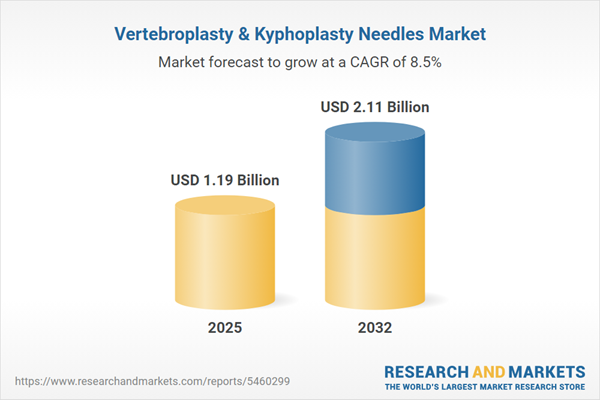Speak directly to the analyst to clarify any post sales queries you may have.
The vertebroplasty and kyphoplasty needles market is experiencing accelerated transformation, driven by technological innovation, evolving clinical practice, and dynamic global supply chains. Senior decision-makers should recognize how strategic investments in product capabilities, supply resilience, and targeted market approaches are shaping the competitive landscape and the future of spinal pain management solutions.
Market Snapshot: Vertebroplasty & Kyphoplasty Needles Market Overview
The vertebroplasty and kyphoplasty needles market grew from USD 1.10 billion in 2024 to USD 1.19 billion in 2025. It is projected to expand at a compound annual growth rate (CAGR) of 8.47%, reaching USD 2.11 billion by 2032. Expansion is being fueled by the rising global prevalence of osteoporotic and traumatic vertebral fractures, along with significant advances in minimally invasive technologies and procedural ergonomics. Competition is also intensifying due to evolving healthcare reimbursement models, cross-border supply chain shifts, and a robust pipeline of device innovation.
Scope & Segmentation of the Vertebroplasty & Kyphoplasty Needles Market
This comprehensive report delivers strategic analysis by delving into multiple market dimensions. The study thoroughly assesses geographic, technological, clinical, and distributional segments, empowering decision-makers to identify growth levers and emerging opportunities. Core segmentation includes:
- Product Types: Kyphoplasty needle (balloon kyphoplasty, radiofrequency kyphoplasty); Vertebroplasty needle (hydraulic injection, manual injection)
- End Users: Ambulatory surgery centers; Hospitals (government and private); Specialty clinics
- Applications: Compression fractures; Osteoporotic fractures; Traumatic fractures; Tumor ablation
- Distribution Channels: Direct sales; Distributors (independent, institutional); Online sales
- Material Composition: Nitinol; Stainless steel (austenitic, martensitic); Titanium
- Regions: Americas (North America, Latin America); Europe, Middle East & Africa; Asia-Pacific
- Key Companies Profiled: Adroit Manufacturing Company, Jayon Implants Pvt.Ltd., Medtronic Plc, Merit Medical Systems Inc., MOLLER Medical GmbH, Stryker Corporation, Suretech Medical INC, Swastik Enterprise, Tecres S.p.A., Teknimed
Key Takeaways for Decision-Makers
- Innovations in needle design, such as radiopaque marking and adjustable tip profiles, are supporting heightened procedural accuracy and minimizing risks in minimally invasive spinal interventions.
- Adoption is climbing across outpatient care settings, with ambulatory surgery centers and specialty clinics driving procedural volume through demand for advanced, ergonomic, and value-based needle systems.
- Regional trends highlight the Americas’ established reimbursement structures, Asia-Pacific’s rapid uptake due to demographic shifts, and increasing harmonization in regulatory requirements across Europe and other regions.
- Strategic partnerships, joint ventures, and local manufacturing are helping companies mitigate supply chain risks and manage cost pressures related to material availability and tariffs.
- Material innovations including nitinol, stainless steel, and titanium are differentiating products by supporting diverse clinical requirements, ease of handling, and compatibility with advanced imaging modalities.
Tariff Impact on Supply Chain and Competitive Strategy
The imposition of US tariffs in 2025 has raised material and component costs for vertebroplasty and kyphoplasty needles, compelling leading organizations to reconsider supplier portfolios and manufacturing locations. This shift is promoting the development of domestic production capabilities to minimize further disruptions and foster deeper collaboration frameworks across the value chain. Hospitals and clinics are also rethinking procurement, increasingly negotiating value-based contracts and exploring bundled purchasing models to ensure cost predictability and supply continuity.
Methodology & Data Sources
Report findings are grounded in primary interviews with interventional radiologists, spine surgeons, procurement experts, and device engineers, supported by surveys, regulatory reviews, peer-reviewed literature, and analysis of company filings. Data triangulation and scenario modeling deliver a robust, credible, and comprehensive perspective on underlying market dynamics.
Why This Report Matters to Senior Leaders
- Enables effective investment planning by providing differentiated insights across clinical, technological, and regional dimensions of the spinal needle market.
- Guides supply chain, procurement, and partnership strategies to optimize resilience in response to tariff and regulatory changes.
- Supports competitive positioning through actionable intelligence on product innovation and evolving user requirements.
Conclusion
Strategic focus on innovation, adaptable supply chains, and stakeholder engagement will empower organizations to capitalize on growth and enhance clinical impact within the vertebroplasty and kyphoplasty needles market. As demographic and clinical demands evolve, tailored solutions and evidence-based strategies remain critical for sustained leadership.
Additional Product Information:
- Purchase of this report includes 1 year online access with quarterly updates.
- This report can be updated on request. Please contact our Customer Experience team using the Ask a Question widget on our website.
Table of Contents
3. Executive Summary
4. Market Overview
7. Cumulative Impact of Artificial Intelligence 2025
Companies Mentioned
The companies profiled in this Vertebroplasty & Kyphoplasty Needles market report include:- Adroit Manufacturing Company
- Jayon Implants Pvt.Ltd.
- Medtronic Plc
- Merit Medical Systems, Inc.
- MOLLER Medical GmbH
- Stryker Corporation
- Suretech Medical INC
- Swastik Enterprise
- Tecres S.p. A.
- Teknimed
Table Information
| Report Attribute | Details |
|---|---|
| No. of Pages | 181 |
| Published | November 2025 |
| Forecast Period | 2025 - 2032 |
| Estimated Market Value ( USD | $ 1.19 Billion |
| Forecasted Market Value ( USD | $ 2.11 Billion |
| Compound Annual Growth Rate | 8.4% |
| Regions Covered | Global |
| No. of Companies Mentioned | 11 |









